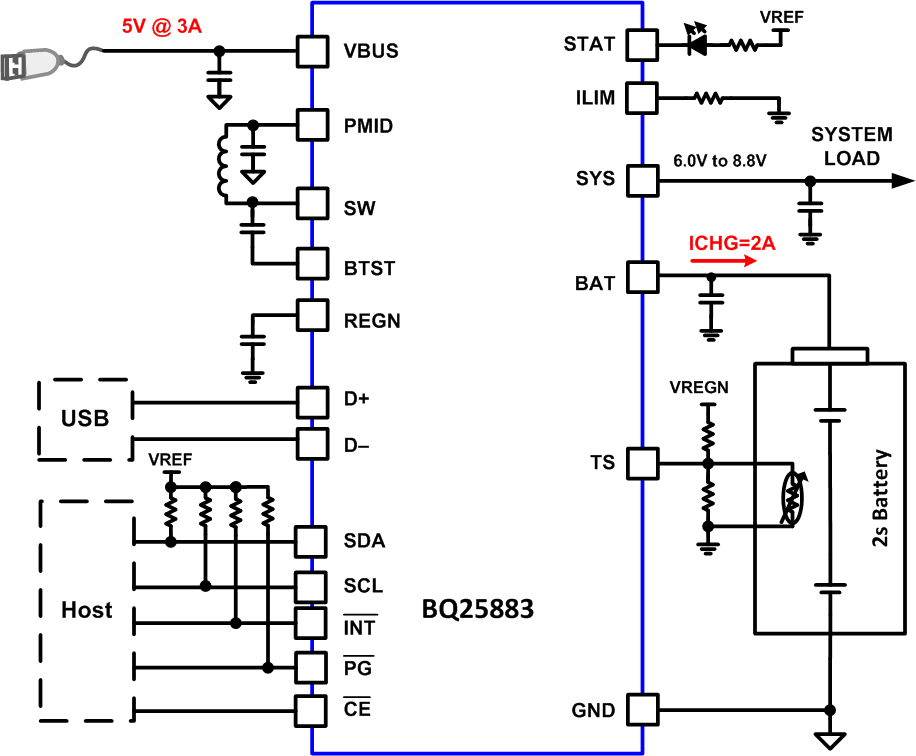JAJSH75A February 2019 – March 2019 BQ25883
PRODUCTION DATA.
- 1 特長
- 2 アプリケーション
- 3 概要
- 4 改訂履歴
- 5 Device Comparison Table
- 6 Pin Configuration and Functions
- 7 Specifications
-
8 Detailed Description
- 8.1 Overview
- 8.2 Functional Block Diagram
- 8.3
Feature Description
- 8.3.1 Device Power-On-Reset
- 8.3.2 Device Power Up from Battery without Input Source
- 8.3.3 Device Power Up from Input Source
- 8.3.4 Input Current Optimizer (ICO)
- 8.3.5 Buck Mode Operation from Battery (OTG)
- 8.3.6 Power Path Management
- 8.3.7 Battery Charging Management
- 8.3.8 Integrated 16-Bit ADC for Monitoring
- 8.3.9 Status Outputs
- 8.3.10 Input Current Limit on ILIM Pin
- 8.3.11 Voltage and Current Monitoring
- 8.3.12 Thermal Regulation and Thermal Shutdown
- 8.3.13 Battery Protection
- 8.3.14 Serial Interface
- 8.4 Device Functional Modes
- 8.5
Register Maps
- 8.5.1 Battery Voltage Regulation Limit Register (Address = 00h) [reset = A0h]
- 8.5.2 Charger Current Limit Register (Address = 01h) [reset = 5Eh]
- 8.5.3 Input Voltage Limit Register (Address = 02h) [reset = 84h]
- 8.5.4 Input Current Limit Register (Address = 03h) [reset = 39h ]
- 8.5.5 Precharge and Termination Current Limit Register (Address = 04h) [reset = 22h]
- 8.5.6 Charger Control 1 Register (Address = 05h) [reset = 9Dh]
- 8.5.7 Charger Control 2 Register (Address = 06h) [reset = 7Dh]
- 8.5.8 Charger Control 3 Register (Address = 07h) [reset = 02h]
- 8.5.9 Charger Control 4 Register (Address = 08h) [reset = 0Dh]
- 8.5.10 OTG Control Register (Address = 09h) [reset = F6h]
- 8.5.11 ICO Current Limit in Use Register (Address = 0Ah) [reset = XXh]
- 8.5.12 Charger Status 1 Register (Address = 0Bh) [reset = XXh]
- 8.5.13 Charger Status 2 Register (Address = 0Ch) [reset = XXh]
- 8.5.14 NTC Status Register (Address = 0Dh) [reset = 0Xh]
- 8.5.15 FAULT Status Register (Address = 0Eh) [reset = XXh]
- 8.5.16 Charger Flag 1 Register (Address = 0Fh) [reset = 00h]
- 8.5.17 Charger Flag 2 Register (Address = 10h) [reset = 00h]
- 8.5.18 FAULT Flag Register (Address = 11h) [reset = 00h]
- 8.5.19 Charger Mask 1 Register (Address = 12h) [reset = 00h]
- 8.5.20 Charger Mask 2 Register (Address = 13h) [reset = 00h]
- 8.5.21 FAULT Mask Register (Address = 14h) [reset = 00h]
- 8.5.22 ADC Control Register (Address = 15h) [reset = 30h]
- 8.5.23 ADC Function Disable Register (Address = 16h) [reset = 00h]
- 8.5.24 IBUS ADC 1 Register (Address = 17h) [reset = 00h]
- 8.5.25 IBUS ADC 0 Register (Address = 18h) [reset = 00h]
- 8.5.26 ICHG ADC 1 Register (Address = 19h) [reset = 00h]
- 8.5.27 ICHG ADC 0 Register (Address = 1Ah) [reset = 00h]
- 8.5.28 VBUS ADC 1 Register (Address = 1Bh) [reset = 00h]
- 8.5.29 VBUS ADC 0 Register (Address = 1Ch) [reset = 00h]
- 8.5.30 VBAT ADC 1 Register (Address = 1Dh) [reset = 00h]
- 8.5.31 VBAT ADC 0 Register (Address = 1Eh) [reset = 00h]
- 8.5.32 VSYS ADC 1 Register (Address = 1Fh) [reset = 00h]
- 8.5.33 VSYS ADC 0 Register (Address = 20h) [reset = 00h]
- 8.5.34 TS ADC 1 Register (Address = 21h) [reset = 00h]
- 8.5.35 TS ADC 0 Register (Address = 22h) [reset = 00h]
- 8.5.36 TDIE ADC 1 Register (Address = 23h) [reset = 00h]
- 8.5.37 TDIE ADC 0 Register (Address = 24h) [reset = 00h]
- 8.5.38 Part Information Register (Address = 25h) [reset = 18h]
- 9 Application and Implementation
- 10Power Supply Recommendations
- 11Layout
- 12デバイスおよびドキュメントのサポート
- 13メカニカル、パッケージ、および注文情報
3 概要
BQ25883 は、2 セルのリチウムイオンおよびリチウムポリマ・バッテリ用の、高度に統合された 2A 昇圧スイッチ・モードのバッテリ充電管理およびシステム電力パス管理デバイスです。BQ25883 は I2C 制御、OTG、電力パスが搭載されています。
製品情報(1)
| 型番 | パッケージ | 本体サイズ(公称) |
|---|---|---|
| BQ25883 | VQFN (24) | 4.00mm×4.00mm |
- 利用可能なすべてのパッケージについては、このデータシートの末尾にある注文情報を参照してください。
概略回路図
